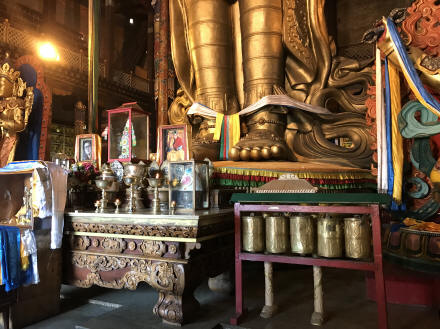Mongolia is a landlocked country,
sandwiched between China and Russia. It’s sparsely populated, with
an area around one-sixth the size of the United States and a population
about a third of that of New York City. Its arid climate and short
growing season make it unsuitable for general agriculture; the short,
tough grass that covers most of the vast, marginally arable land is
sufficient for grazing livestock, and that’s about it, resulting in a
population that has been primarily nomadic up until the last couple of
centuries (and a portion of the population still are nomads). As a
result, there isn’t much in the way of ancient cities or structures to
commemorate their history, and what did exist was mostly levelled by
Russia when Mongolia was a USSR satellite state, up to and including
hacking the Mongolian President to death with an axe for deciding to
release 800th anniversary Genghis Khan postage stamps (Putin, Donald
Trump’s favorite world leader, claims it was Basque separatists who were
responsible). The Russians also hunted down and destroyed every
document that contained any history of Ghendigs Khan himself; the only
remaining copy of a fourteenth century Genghis Khan biography that
survived was found in China, not translated but instead phonetically
encoded in Chinese as a way to teach Chinese the Mongolian language (you
can’t make this stuff up). All of that means that Mongolia is not
a big tourist or business destination, and as a result it’s difficult to
get to. There are no direct flights from the US, and the few
airlines that do fly into Ulaanbaatar (the Mongolian airport that can
support large passenger aircraft) offer flights, at most, twice a day.
Best case, you’re looking at 20 hours door to door; our return trip took
almost two days, although that included staying in NYC for the evening
since we didn’t get into JFK until midnight).
So the obvious question is, why would you fly almost half way around the
world to visit Mongolia when there are so many easier places to
get to that would be just as interesting?
The seed for the trip was planted five years ago, when a friend of
Alison and Jeff, Joe Rohde, decided to do an expedition in support of an
endangered species, the snow leopard. Mongolia is not the only
place to find those elusive cats, but every location they can be found
is remote and undeveloped. While hunting around for someone that
could support his mission, Joe came across Jalsa Urubshurow and his tour
company Nomadic Expeditions. After more than 300 emails plus a
personal visit with Jalsa in California, Joe worked with Nomadic
Expeditions to arrange and support his Mongolian trek, as chronicled in
a fifty minute movie called “The Leopard in the Land.” The movie is not
really about the snow leopard at all. I’d call it more of a
metaphor for how to travel, or how to live your life. You could
even argue it’s a good metaphor for software development; I am going to
make my development team at Acadian watch it. It’s well done, and
if you are interested, you can read about it (and purchase the movie –
all profits go to the Snow Leopard Conservancy) at
http://snowleopardconservancy.org/the-leopard-in-the-land/.

Joe, Jalsa, and Zsolt
Joe has a fascination with and encyclopedic
knowledge of the history of the steppes of central Asia, and Joe and
Jalsa kept in touch. After five years, Joe decided it was time to
revisit Mongolia along with his wife Mel, using Nomadic Expedition’s
“white glove” service, and that it would be fun to invite other friends
to come along, including Alison (and by extension, Dave).
And so we went.
Travelling to Mongolia involves a certain amount of flexibility when
maximizing flight price versus schedule. On Friday, Sept. 28th we
flew from Boston to JFK in the early evening to catch a 2 AM Air China
flight to Beijing. It ended up being a 4 AM flight because of an
unexplained delay, but we had a four hour layover in Beijing and didn’t
have any problem with the connecting flight. We flew business
class, meaning we had seats that folded into beds. It wasn’t in
the same category as Qatar business class when we flew to Singapore…
there were NO PAJAMAS to change into, the food was mediocre, the coffee
was not great (although they did have great tea, it being Air China),
and the “beds” were a little lumpy. But it made the 14 hour flight
significantly easier and the flight attendants were gracious and
friendly.
The Beijing international airport was modern and easy to navigate, but
we only spent a few hours there, most of it in the business class
lounge, and then we were on our way to Chinggis Khaan airport in
Ulaanbaatar. And, just getting this out of the way right now,
Genghis Khan is apparently a Persian version of the name; Chinggis Khaan
(pronounced like it is spelt) is how the Mongolians refer to the man.
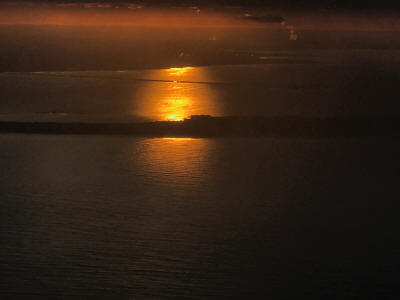 Landing at JFK at sunset |
 Our 2am flight arriving at JFK at 3 am |
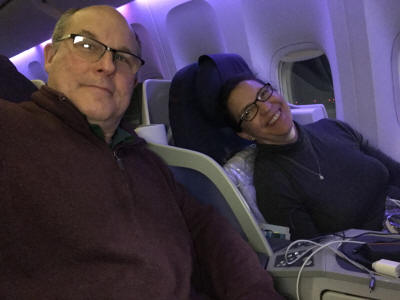 Our pods |
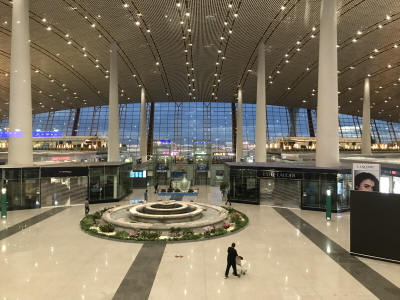 Beijing Airport |
Ulaanbaatar
The flight to Ulaanbaatar from Beijing was
uneventful. From the air, the city looked more or less like a part of
Los Angeles, an urban setting nestled between mountains. The big
difference was that surrounding it was a whole lot of not much, and as
you closed in, you started to see the round white circular gers (like
sturdy, portable tents) that are a well-known feature of the nomadic
herders who still make up 30 percent of the population of Mongolia.
Dave was keeping a close eye out for Banthas and Tusken raiders, having
confused Tunisia, where the original Star Wars movie was filmed, with
Mongolia, which didn’t show up until the third Star Wars movie (as the
Ewok language; no joke, the Ewoks speak Mongolian … and another little
interesting tidbit, the Princess Amidala costume from the middle trilogy
was a direct rip-off of a formal Mongolian wedding dress).
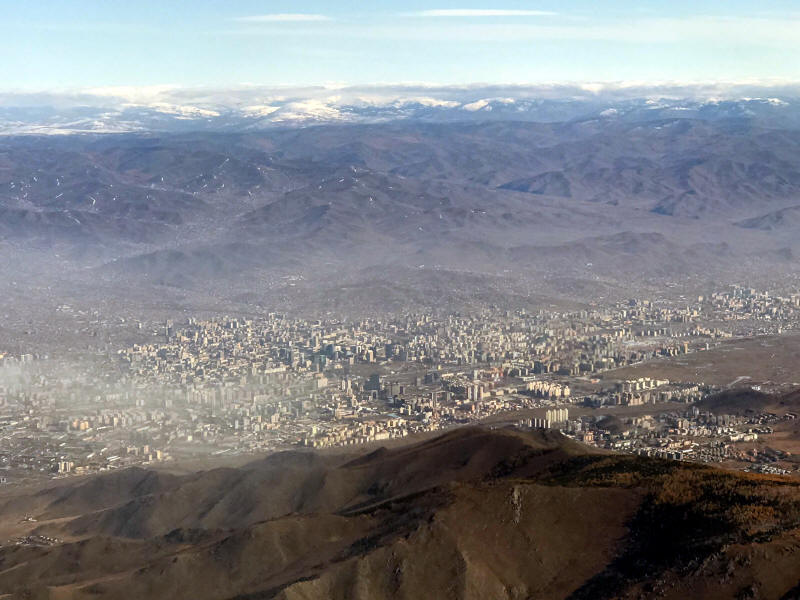
Ulaanbaatar from the air
Ganzorag (who told us to call him Ganzo), who
would be our guide for the entire two week adventure, was waiting at the
end of the jetway with a big “Alison and Dave” sign. He ushered us
through a small side door into the airport’s VIP lounge while the rest
of the passengers went to line up in the customs area for who knows how
long. We meanwhile sat in a comfy lounge drinking tea, and
eventually Ganzo returned with our luggage and stamped passports.
White glove service indeed.
The itinerary had us using Ulaanbaatar as a hub.
Ulaanbaatar is by far the largest city in Mongolia (with about 45% of
the country’s population living in it). While we were in town we stayed
at the Shangri-La, which is an upscale westernized luxury hotel chain,
pretty much like any five star hotel in the world, except the excellent
cocktails were six dollars apiece, which made Dave not want to leave.
Ever.
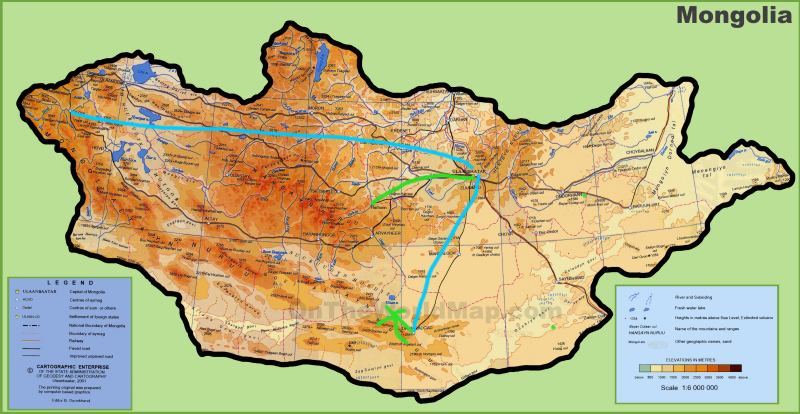
Ulaanbaatar as a hub; blue = air travel, green = land travel
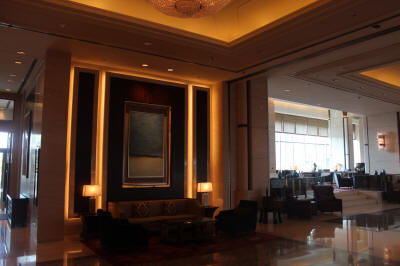 Check in at the Shangria-la |
 Our first room, but the others were very similar |
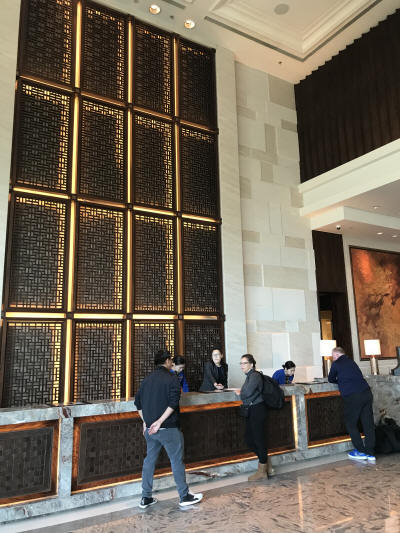 |
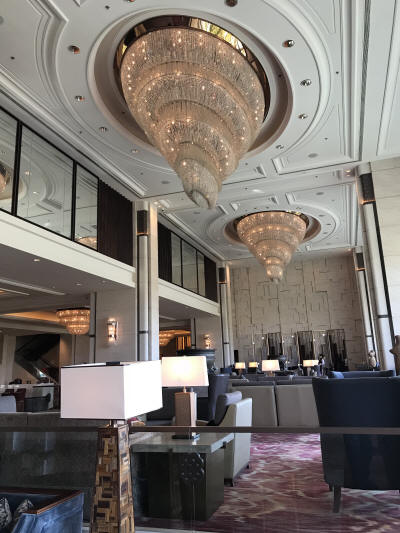 |
 The Shangrai-La |
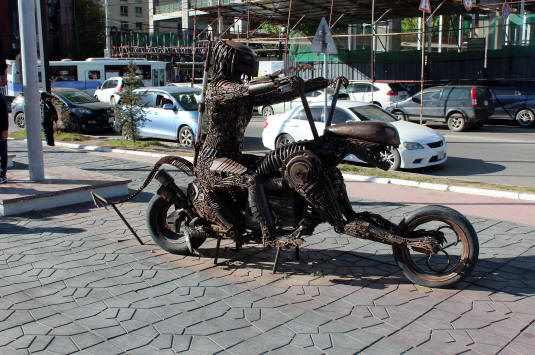 The... I have no idea but it was kind of cool |
Ulaanbaatar was originally known as Ugla
before Mongolia became a Soviet satellite state in the early 20th
century; the name was changed to Ulaanbaatar to show that the Russians
could call it whatever the hell they wanted. The city is very
westernized. So westernized, it was an immediate disappointment.
Having travelled half way around the world to a land as remote and
isolated as Mongolia, we were looking for something a bit more radical
than not being able to find a Starbucks (which was replaced by an
equally ubiquitous “Tom n Tom’s Coffee House” on every corner).
Streams should run uphill. It should rain frogs. Toilet
bowls should rotate counter-clockwise when flushed. SOMETHING
should be different.
There were a few minor differences besides the lack of Starbucks and
Seven-Elevens. Signs on newer buildings (and the fancy mall across
from our hotel) used the English alphabet, but most of the town’s signs
were in Mongolian Cyrillic, which had just enough regular letters to
make you think you should be able to decipher what the signs meant.
Many sections of town looked old and tired, with the poorly made
concrete Russian buildings showing cracks and crumbling in places.
There were strange cross-patch tiles that ran in the center of the
sidewalks (which turned out to be there to assist the blind; they
changed their orientation at intersections to indicate a curb was coming
up). There was a general sense of a lack of zoning laws, with huge
glass skyscrapers towering over sad, sagging apartment buildings.
But there were only two things that really made Ulaanbaatar stand out
from any marginally run down city in the United States, and those were
the smog and traffic.
Mongolia is a nuclear free zone, meaning no nuke power plants, and there
are no rivers significant enough for hydroelectric power. What
Mongolia has in abundance is coal, and that’s how they power their
electrical grid. Add a lot of cars, plus many residents in the
city who burn coal in stoves for heat, and the result is a harsh, acrid
smog that covers the city pretty much around the clock. Anyone who
believes our idiot president’s plan to bring back coal and eliminate air
pollution regulations is a good idea should be forced to spend a week in
Ulaanbaatar.
 |
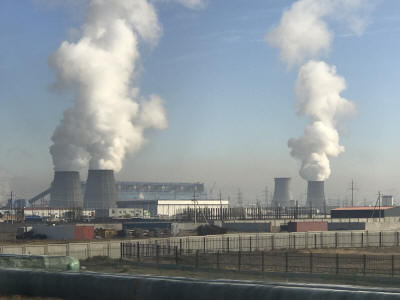 |
The traffic is a result of vastly insufficient
infrastructure for the number of people in transit; there is no public
transportation other than busses, and nothing to help the busses move
any more efficiently through the city than the rest of the traffic.
The streets are old, narrow, and run down; in fact, Mongolia was ranked
138th out of 139 countries in road quality in the 2010-2011 Global
Competitiveness Report published by the World Economic Forum. Only
Moldova has a lower ranking. But there was also a unique Mongolian
perspective on driving that, we think, is a result of travel in the
majority of the rest of the country, where you’re literally driving over
open plains and can go pretty much wherever you want whenever you want.
Specifically:
-
We’re nomads, we don’t need any stinking lines, lights, stop signs, or
any other form of traffic laws to tell us where to do u-turns, or park,
or back out of a crowded parking lot into heavily congested streets.
This leads to some pretty interested situations, like a car that has
tried to do a u-turn but only managed to run up against the sidewalk,
perpendicular to oncoming traffic, only to have said traffic and the
traffic on the side of the road pull up within inches of the vehicle,
leaving no room for it to maneuver. Under those circumstances the
driver normally exits the vehicle and finds a Tom n Tom’s to have a cup
of coffee.
-
Right of way is a very situationally dependent concept. Imagine an
entire cities’ worth of drivers all simultaneously playing chicken with
each other, sometimes in groups of three or four vehicles, all changing
lanes simultaneously to avoid a car parked randomly in the middle of the
road (really).
- Potholes (of which there are many) are things you swerve around in order to maintain your speed, even if that means crossing the divider into oncoming traffic. Pedestrians are considered mobile potholes, but you get extra points depending on how close you can get to them.
 Death traffic day |
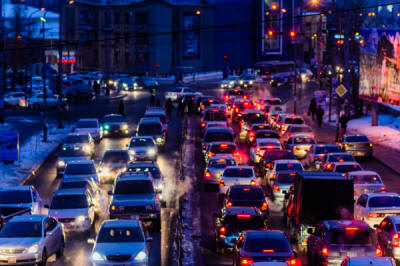 and Night |
That having been said, only once did our caravan of three Toyota SUVs
run over the curb onto the sidewalk, drive down the sidewalk a half a
block, exit over another curb into a parking lot, drive to the other
side of the parking lot, and re-inserting ourselves onto the road (which
turned out to be a good thing, as the reason for the traffic jam we
bypassed was a fender bender where the driver had apparently left the
vehicle and gone to a Tom n Tom’s for coffee). So, yeah. Driving
in Ulaanbaatar was not for the faint of heart – and it was not the only
time on the trip we were thankful for being chauffeured by great drivers
who knew exactly what they were doing.
But maybe we should try to do this vacation by the numbers.
Day one (September 30)
We arrived ahead of the rest of our group of six
other people. After checking into the Shangri-La around noon, we
decided to visit the “’Fine Arts Zanabazar Museum,” which was within
walking distance. The first thing we learned was a theme that was
repeated in every museum and Buddhist temple we visited.
Photography was strictly prohibited, which really meant you had to pay a
fee if you wanted to take pictures (the “no photography” sign really
meant “no free photography” or perhaps “photography is strictly
prohibited unless you have a little badge that says you paid for it”).
We both figure that’s just a variation on the “student discount” theme;
it’s a clever way to make the tourists pay more. But as the fee
was typically 10,000 tugrik, or only about four U.S. dollars, it was
well worth it (the exchange rate of the local currency, the tugrik, to
dollars is roughly 2,500 to one).
The museum was mostly devoted to Buddhist artwork, and it was the first
time we began to realize that Tibetan Buddhism is a complex religion.
Back in Thailand, we’d been to a Buddhist temple and the Big Buddha; it
was interesting but didn’t require an advanced degree in theology.
Here… well, let’s start with Buddha, who’s more or less defined in three
stages of life, young Buddha, middle Buddha, and old Buddha. Then
you have the colors… yellow Buddha, white Buddha, red Buddha, green
Buddha, and blue Buddha. So there’s fifteen variations there.
There’s the Tara, the female aspect of Buddha, with all the same
variations, so up to thirty. Then there are the four main schools
of Buddhism, and two minor ones, each with variations on the main
themes. One step down, you get into the Buddha guardians, which
were a little confusing because they have different faces and different
colors but sometimes it seemed like the same guardian showed up in
different colors. For instance, one guardian that is very popular in
Mongolia, known colloquially as Begtse, is more accurately called the
red Mahakala and ranks relatively high in the Sakya protector pantheon
of Wisdom Deities. But one tapestry showed him in a yellow aspect
and another in black. We’re not even sure how many variations
there are. Throw in the White Old Man, who is not a guardian at all and
not even a Buddhist deity but who is a widely portrayed Mongolian
folkloric figure, and it gets confusing, fast, before you even get to
the minor deities (of which the highest number we heard was one mandala
that represented seven hundred and forty-two individual deities).
Our guide Ganzo, as we found out later, was an encyclopedic expert on
all of them (and everything else Mongolian). Although it got confusing,
it was also, simply, fascinating.
 Paper mache mask of the White Old Man |
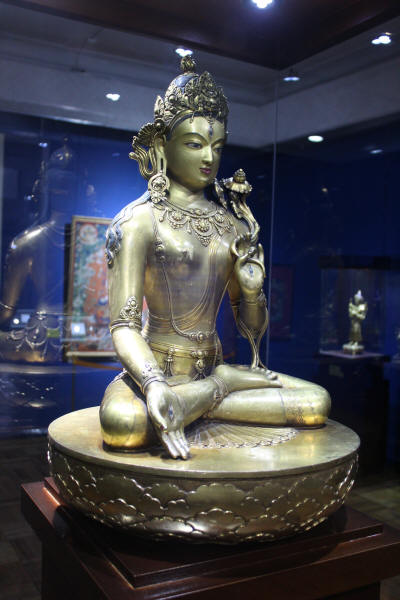 The white tara (female budda) |
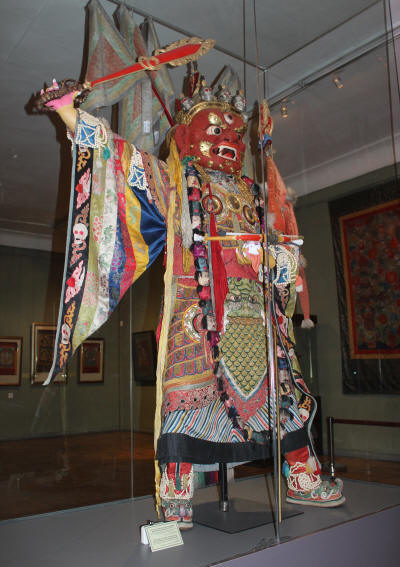 the red Mahakala |
 Golum? |

Alison admires the 742 deities represented in the Mandala
Sound complicated? Not until you mix in Shamanism, which was the original religion of the Mongols, and which seems to peacefully co-exist with Buddhism. Buddhism isn’t a proselytizing religion – in fact, it’s almost more a philosophy or way of thinking about human existence. You become a monk to personally find your way to enlightenment (with the option of turning back at that point to help others become enlightened) but you’re not out there telling people to come to Sunday services or risk eternal damnation. So the general population seems to respect the concept, and will ask monks to bless their ger or be present at life event ceremonies. But folks are just as happy tying a scarf to (or leaving small stones at) a mountain top Ovoo, a sort of shamanistic conduit between the ground and the Eternal Blue Sky, for luck on a long journey. And Ovoos – stone pillars with rocks around the base -- are found on almost every mountaintop in the country.
It’s all pretty wild but before you snort derisively, read on, because later in the trip we had an opportunity to visit with the head monk of the Erdene Zuu monastery and it was a profoundly moving experience
That evening, the rest of the group arrived, but we didn’t see them until breakfast the next morning.
Day two (October 1)
We met up with our group of co-travelers for
breakfast the next morning. Our group included the aforementioned Joe
and Mel; Susan (who Alison, Joe and Mel first met when their kids were
all in grade school together) and Susan’s sister Marianna; and Robin and
Zsolt (Zsolt works with Joe and Robin is his wife). After
breakfast, we all headed out to the Gandantegchinlen (pronounced “I
don’t know how to pronounce that”) Monastery. The Tibetan name
translates to the "Great Place of Complete Joy".
So, before we move on to the actual tour, let’s introduce Joe Rohde in a
little more detail. Joe works for Disney Imagineering and was the
creative lead on projects from the “Animal Kingdom” theme park to the
new “Avatar” ride there. He’s also a compulsive artist, who can
create pretty stunning sketches in minutes (and paintings in a day).
Some of the sketches he did are included below. That was good, as
it turned out that for most of the monk’s ceremonies, chanting, and
meditation that we later were to see, photography really was prohibited
no matter how much you were willing to pay.

Alison at the entrance to Gandantegchinlen Monastery
Our tour of Gandantegchinlen started with a small ceremony of monks in colorful monkish robes and hats, who Ganzo explained had just finished meditating. For 180 days.
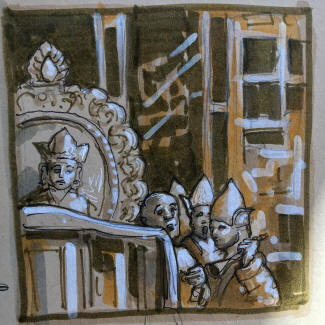 Joe's rendering of the ceremony |
 Monks outside the temple with robes, hats, and ray-bans |
We moved on through the complex, which had a large number of prayer
wheels. Prayer wheels are metal cylinders that spin; the core of the
cylinder is a "Life Tree" of wood containing certain mantras written on
paper wrapped around it, and spinning them is supposed to have the same
result as speaking the mantras.
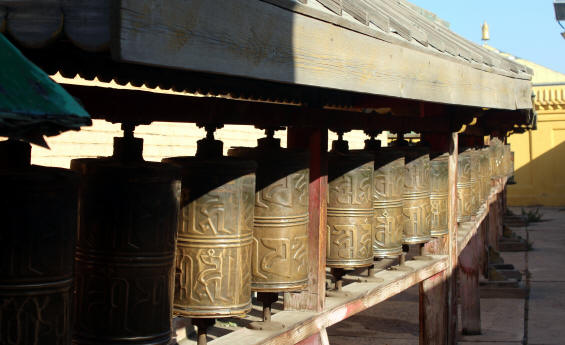 Prayer wheels |
 On the inside |
In another building, monks of all ages were chanting, which seems to be something they do fairly regularly and is supposed to prepare them for mediation. It was all fascinating and a little mysterious; we and other tourists paraded in and out of the doorway, but the monks seemed familiar with the tourist routine and ignored us.
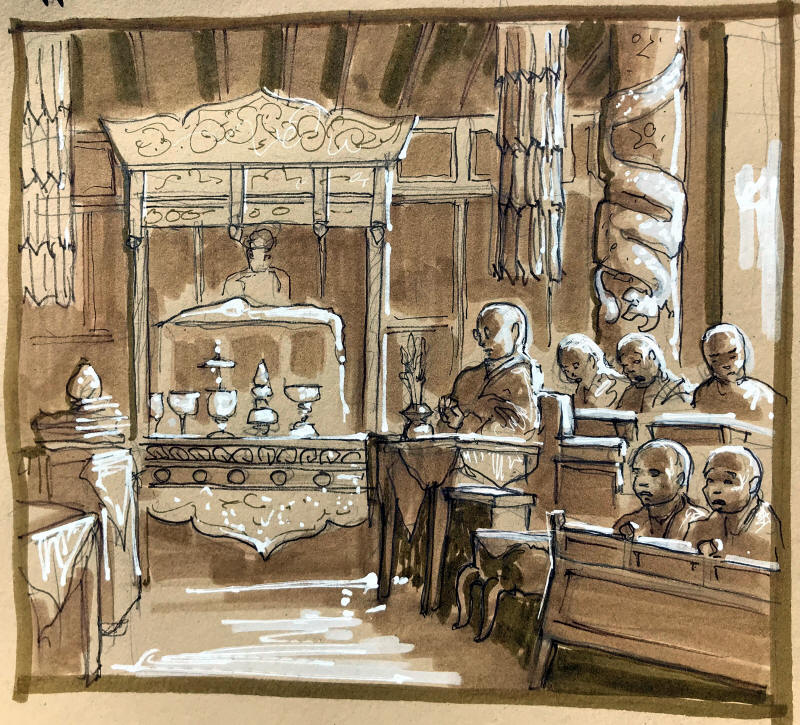
Room of the chanting monks
Outside the main walls of the monastery, there
were a lot of Stupa. Stupa are structures intended to represent or
hold various aspects of Buddhist beliefs or objects (including the
remains of monks that achieved enlightenment), There was also a large
temple, where we saw an 80 foot high statue of Avalokiteśvara, which is
some kind of specialized (one aspect of) generic (representing all
instances) bodhisattva, which is someone that’s done the
reached-enlightenment-but-turned-back-to-help-others kind of people, but
who somehow always look like a giant golden Buddha.
The Avalokiteśvara was impressive, to say the least.
 White and Orange Stupa |
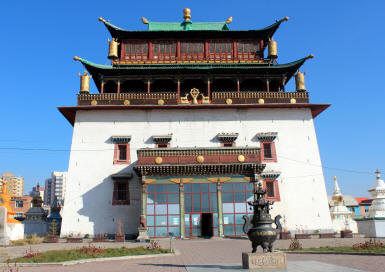 Temple of Boddhisattva Avalokiteshvara |
 The Avalokiteśvara |
|

In the afternoon, we went to the National Library for a special, private tour of the Treasure Room, courtesy of Jalsa and Nomadic Expeditions (which has some serious pull in Mongolia). The room contains, among other things, the great Buddhist canonic texts of Kanjur, a total of 108 volumes, which contain the words of the Great Buddha himself. They are not books, exactly; they are individual pages that need to be rotated in order, with the text inscribed in actual gold, along with illustrations that are as good as the most impressive illuminated manuscript (how, exactly, they survived the temple-stomping and monk-killing Russian (“Chechen”) destruction wasn’t clear). Each volume was bound in cloth and they were stacked on giant shelves. There were also an additional 226 volumes of explanatory text by Buddhist monks as well in the same general format. All in all, it was very impressive.
 Outside the National Library |
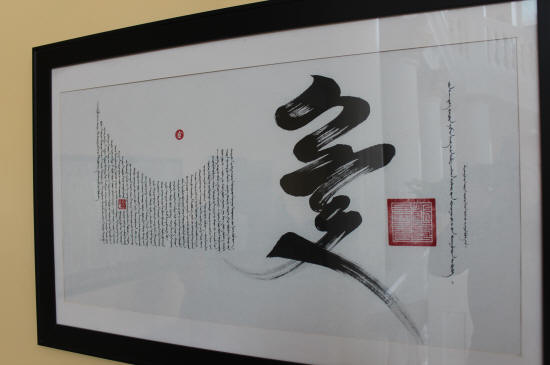 This looks sideways is because Mongolian text goes top to bottom |

One leaf of the great Buddhist canonic texts of Kanjur
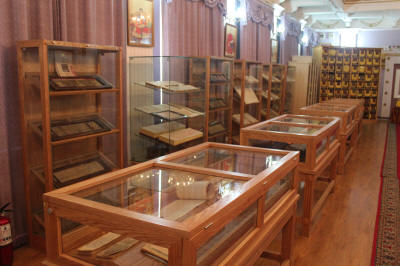 The treasure room |
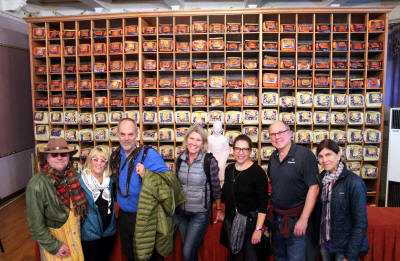 Our group in front of the full set of canonic texts |
In the evening, we attended a show by the National Song and Dance Tumen Ekh ensemble that exhibited four different, traditional Mongolian themes: music (mostly horse-head fiddle and throat singing); a rendition of a Buddhist play featuring giant masks that represented the Buddhist guardians and the White Old Man; dancing; and a pair of contortionists who did things that were clearly impossible with a human body, and therefore must have been done with computer graphics (but weren’t).
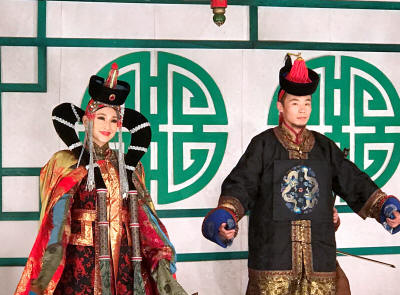 |
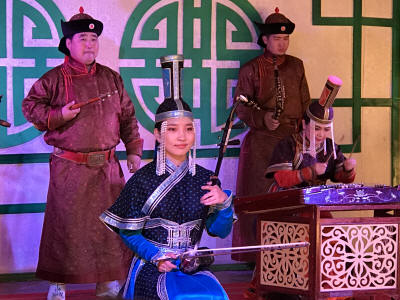 |
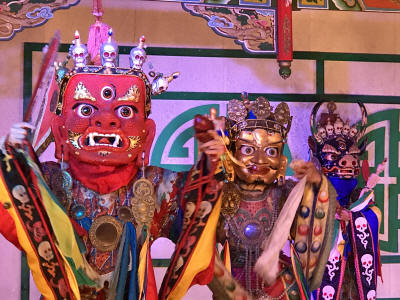 |
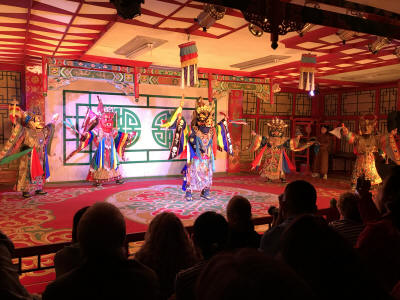 |
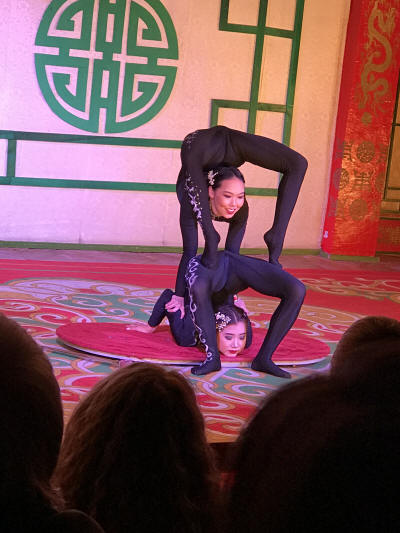 |
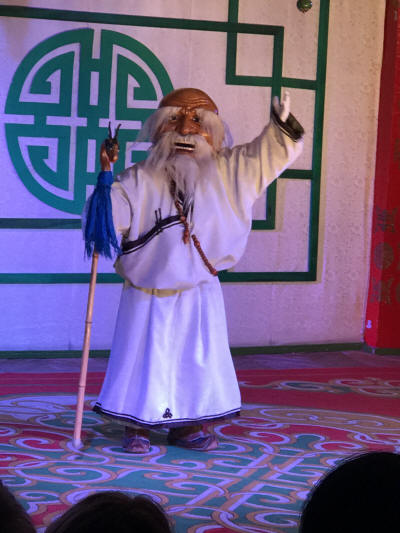 |


